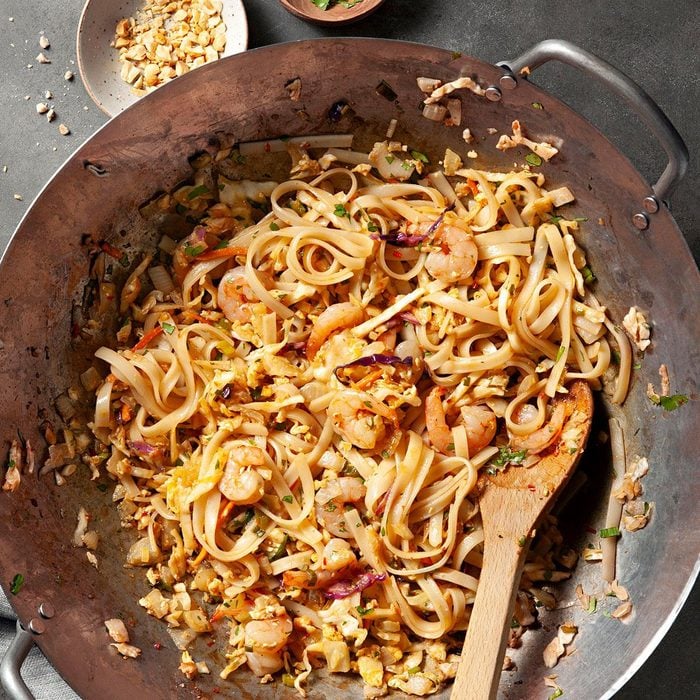While authentic shrimp pad thai is undeniably delicious, sourcing some of its specialty ingredients—like tamarind sauce and an array of fresh Asian vegetables—can be difficult and cost-prohibitive depending on your location and budget.
Luckily, this simplified shrimp pad thai recipe makes it possible to enjoy a flavorful plate, even on your busiest weeknights. With tender noodles, succulent shrimp and a balanced sauce with sweet and umami flavors, this pad thai with shrimp is easy enough for any home cook to master. It takes 30 minutes and is made with easy-to-find ingredients, so you can make shrimp pad thai your new “takeout fake out” recipe.
What is pad thai?
Pad thai is a popular Thai recipe. It consists of stir-fried noodles bathed in a sweet, sour and savory sauce. Often made with shrimp (or prawns), chicken or tofu, pad thai also contains scrambled eggs and bean sprouts, and is typically garnished with crushed peanuts, cilantro and a squeeze of lime.
The ingredients in the sauce are what give the dish its distinctive flavor, but they vary greatly from recipe to recipe. In classic pad thai recipes, a combination of fish sauce, dried shrimp, tamarind and palm sugar is used to give the recipe its iconic funky, fishy, sweet and sour flavor. Westernized versions, however, will often call for ingredients like lime juice, ketchup, brown sugar and soy sauce in an attempt to replicate the flavors of classic pad thai. Our recipe for pad thai with shrimp finds a great middle ground between the two.
Ingredients for Shrimp Pad Thai
- Shrimp: For this recipe, use medium uncooked shrimp (look for a bag that has 41 to 50 shrimp per pound). You can pick a type of shrimp that has been peeled and deveined for you, or clean the shrimp yourself to save a few dollars. If using frozen shrimp, make sure to thaw them completely before preparing.
- Rice noodles: Pad thai with shrimp begins with a bed of these long tendrils. Rice noodles cook quickly and have a mild taste perfect for soaking up the flavors in the delectable pad thai sauce.
- Onion and garlic: These two aromatics add depth to the flavor of shrimp pad thai. Feel free to increase or decrease the amount of garlic to suit your taste.
- Egg: The soft, spongy texture of scrambled egg is perfect for soaking up sauce, and contrasts nicely with the crisp vegetables and tender shrimp.
- Coleslaw mix: A bag of coleslaw mix is an easy shortcut ingredient for semi-homemade recipes. In pad thai, cabbage replicates the taste and texture of bean sprouts.
- Rice vinegar: Our recipe calls for rice vinegar. It’s sweeter than other types of vinegar and offers a similar combination of sweetness and acidity to that you’d get from tamarind puree.
- Sugar: In authentic shrimp pad thai, palm sugar is a popular choice. This version opts for granulated sugar to give the sauce added sweetness. You could also use brown sugar, coconut sugar or even honey.
- Soy sauce: A splash of soy deepens the color of the sauce and lends some necessary umami that balances the sweet and sour flavors in the dish. Choose low-sodium soy sauce if you are watching your salt intake.
- Fish sauce: This is an essential Thai ingredient for pad thai because it gives the dish its characteristic fishy flavor. If you want to make a vegetarian pad thai, you can swap the fish sauce for additional soy sauce—but the flavor will not be quite the same.
- Chili garlic sauce: This condiment gives the shrimp pad thai some spice and heat. For a mild pad thai, you can omit it. You can also use Sriracha, sambal oelek or gochujang if you have them on hand.
- Garnishes: A shower of chopped peanuts, a sprinkle of cilantro and green onions, a squeeze of fresh lime juice: These are just a few great ways you can finish a heaping plate of fresh-from-the-wok shrimp pad thai.
Directions
Step 1: Cook the noodles
Cook the rice noodles according to package directions.
Editor’s Tip: Unlike wheat pasta, many commercial rice noodles do not need to be boiled. They can simply be soaked in warm water until tender. Check the package directions for recommendations. Take care not to let them soak for too long, otherwise they may become mushy and gummy.
Step 2: Prepare the shrimp
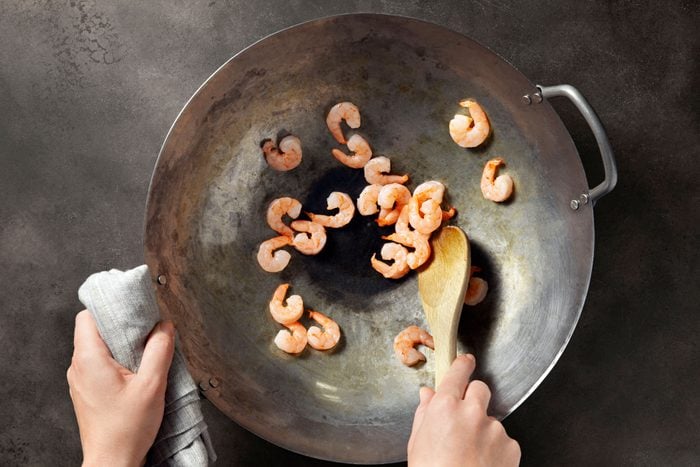
In a large nonstick skillet or wok, stir-fry the shrimp in oil until they turn pink. Remove them and set them aside.
Editor’s Tip: Don’t make the mistake of overcooking your shrimp to the point where they become dry, tough and rubbery!
Step 3: Add aromatics and eggs
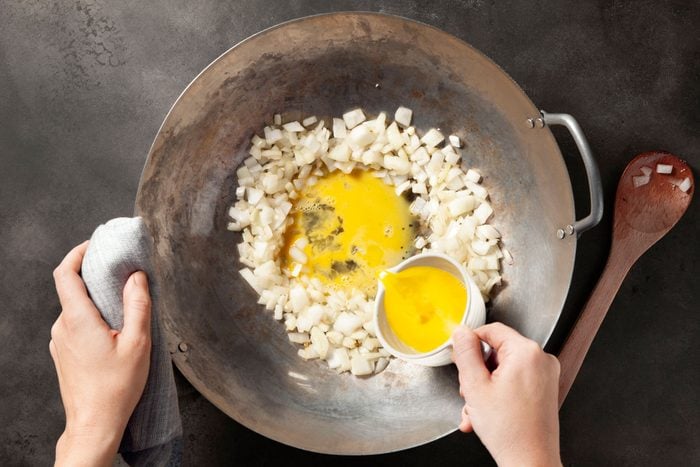
Add the onion and garlic to the pan. Make a well in the center of the onion mixture and add the egg. Stir-fry for two to three minutes or until the egg is completely set.
Editor’s Tip: Garlic burns very easily. To prevent this, only let the onions and garlic cook for a few seconds before adding the egg.
Step 4: Add the veggies and sauce ingredients
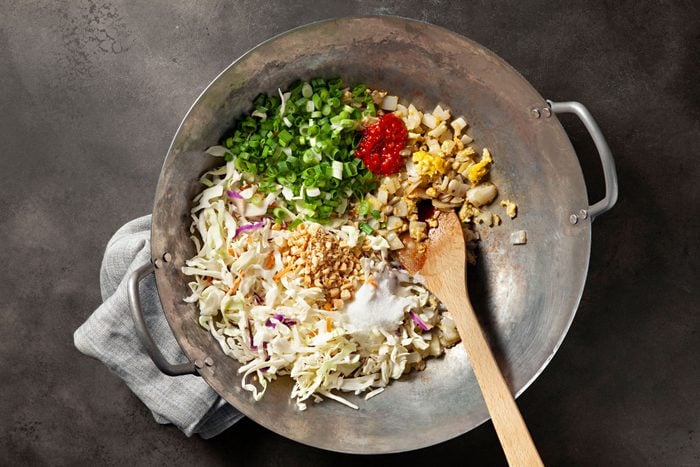
Add the coleslaw mix, green onions, vinegar, sugar, soy sauce, fish sauce, chili garlic sauce and peanuts, and heat them through. Return the shrimp to the pan and cook until heated through.
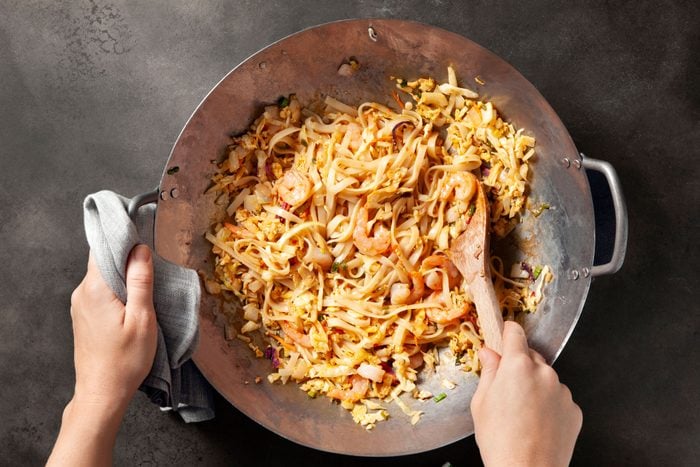
Editor’s Tip: Ideally, the coleslaw mix and green onions should still be slightly crisp. Their slight crunch offers a nice contrast of texture to the soft egg, tender noodles and juicy shrimp.
Step 5: Combine and serve
Drain the noodles and toss them with the shrimp mixture until they’re evenly coated in the sauce. Garnish the pad thai with cilantro and additional chopped salted peanuts.
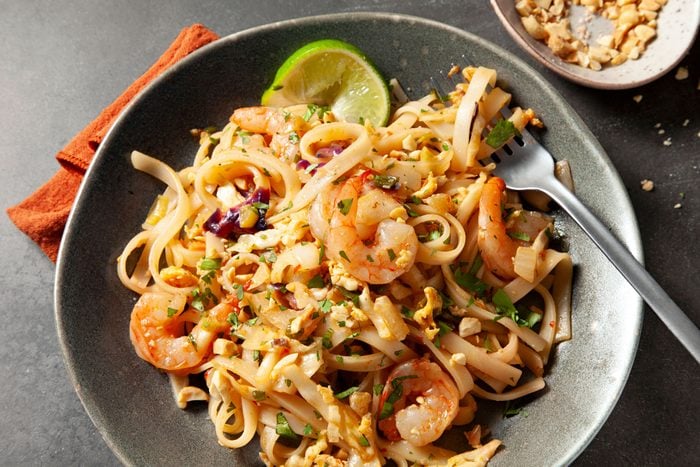
Shrimp Pad Thai Variations
- Add other vegetables: For added texture and nutrition, you can load your shrimp pad thai with other vegetables you enjoy. Bean sprouts are a traditional addition, but thinly sliced bell peppers, grated carrots or zucchini noodles also taste great.
- Try different noodles: Thin or flat rice noodles are used in classic pad thai, but you can swap them for vermicelli, glass noodles, ramen noodles or Thai egg noodles if you prefer.
- Swap out the shrimp: If you don’t like shrimp, you can also make chicken pad thai. Use 1/2 pound of thinly sliced chicken breast or chicken thighs, cut into bite-sized pieces.
- Make it vegetarian: Omit the shrimp and cut a block of tofu into 1-inch cubes before adding it to the recipe to make vegetarian pad thai. You’ll also want to leave out the fish sauce and swap it for soy sauce.
- Spice it up: This shrimp pad thai recipe is pretty mild, but you can kick it up a few notches by adding extra chili garlic sauce or your favorite type of peppers. Jalapeno is an easy, accessible option, but if you have access to Thai chiles—like prik kee nu or bird peppers—feel free to toss them in.
How to Store Shrimp Pad Thai
Pad thai with shrimp may be refrigerated for up to three to four days in an airtight storage container, or frozen for up to three months. To reheat, warm pad thai gently in the microwave. You can also warm pad thai in a covered skillet with a splash of water until it’s heated through.
Shrimp Pad Thai Tips
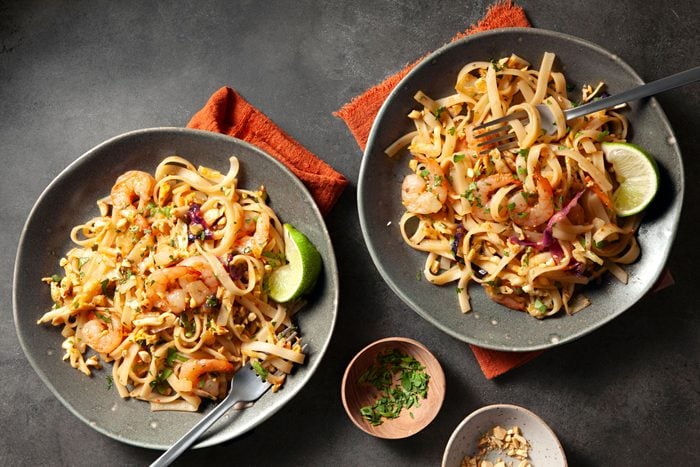
Can you make shrimp pad thai ahead of time?
You can make shrimp pad thai ahead of time, but it’s best made fresh so that the noodles don’t get soggy. To save time on chopping and measuring, do some of the prep work in advance. Try mixing up the sauce ingredients the night before in a small, separate container. You can also chop and mince the onions, garlic, cilantro and peanuts ahead of time and store them in separate containers until you’re ready to cook. Alternatively, try slow-cooker pad thai when you don’t have time to prep right before dinner.
Can you use precooked shrimp for shrimp pad thai?
Using precooked shrimp is another great, time-saving hack when making pad thai. Make sure they’re defrosted, then add them toward the end with the vegetables and allow them to heat through.
What else can you serve with shrimp pad thai?
Serve shrimp pad thai with a Thai peanut naan pizza appetizer that’s perfect for sharing. This Thai-style Cobb salad or Thai asparagus with mushrooms are some light options that complement shrimp pad thai.



















